Text
Hong Kong Action cinema (Blog 5)
For my last blog post about Hong Kong action cinema, I will be discussing the critical reception for some of John Woo’s films. First, I’d like to discuss the relationships and masculinity present in John Woo’s films, as it is very present in a lot of his films.
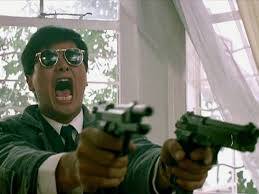
Jillian Sandell in Reinventing Masculinity states how “Woo is famous for his vision of intense male friendships-depicted through his trademark blend of breaktakingly choreographed action sequences” (Jillian Sandell, 23). These male relationships are a common thing to happen in Woo’s action films, and it goes hand in hand with loyalty.
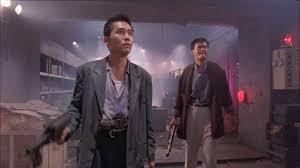
His movies have “tragic and sentimental plots about the place of loyalty and honor in a corrupt and violent world” (Sandell, 23) and a perfect example can be seen in Hard Boiled with the relationship between Tequila and Alan. A big reception of John Woo’s movies is a positive one, but it is out of the ordinary compared to Hollywood. Sandell states how Woo’s films model a certain type of masculinity “that combines an understated emotional intensity with the physical strength and expertise of a deadly killer” (Sandell, 23) which differs from Hollywood which “celebrate(s) the male body in a very literal way (with the protagonist exposing his muscular, and frequently wounded, torso)" (Sandell, 23).

Another recurring theme in Woo’s films, that he gets praised for, is the use of Wuxia cinema. The idea of Wuxia cinema is creating concrete heroes who “have a spiritual function as well as a martial arts function” (Qiao Li and Lei Deng, 65). We see in John Woo’s films the presence of martial arts, and John Woo does not put martial arts in there for no reason. It represents the spirit of xiayi. Wuxia cinema started in the 1950s in Hong Kong cinema, and John Woo ran with it. John Woo uses a lot of wuxia in his films, specifically in Hard Target when Chance helps Natasha figure out her father was killed. He then risks his life for her trying to get revenge for her father’s death.
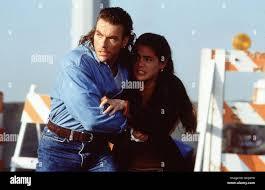
In Chinese culture “Xia is always ready to help others (even strangers) for a just cause” (Li and Deng, 65) which we see in Hard Target. “It represents a symbol or a code for certain aspects of the Chinese traditional culture… when Woo moved to Hollywood, he did not abandon this core cultural element” (Li and Deng, 65). This is what separates Woo from the others and the public is able to recognize this and praise it. He never abandons where he came from in his films and he defines a warrior and fighter as someone else, someone who has a different type of fight than the ones in Hollywood films.
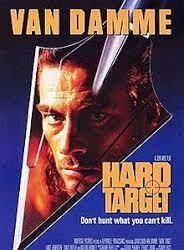
The critical reception for Hard Target was very solid. It was Woo's first film that wasn't made in Hong Kong, and this is because he was doing so well he went to Hollywood. Duane Byrge, from the Hollywood Reporter, labels it “a blazing blend of Woo’s hard-boiled visual histrionics… smartly torched by Woo’s technical expertise” (Duane Byrge). Woo displays his unique directing style for Hard Target. Woo’s use of quick-cutting angles mixed with slow motion with tight fight scenes is remarkable, with a touch of suspense and revenge to top it off.
youtube
It is a great movie about getting revenge on an organization hired by wealthy people to kill. Like I mentioned above, Chance is the one trying to get revenge and it’s that Chinese touch, with wuxia being in play. Woo’s use of action sequences incorporated into the theme of revenge and justice is the perfect blend, which is why he is so great.

While Hard Target showcases all of Woo’s skills piled into one film, Hard Boiled keeps away the revenge theme, with Tequila avenging his cop partner, and gives us even more gun-fu. With some of Woo’s greatest action sequences, and one of the greatest long takes of all time (the elevator in the hospital scene) this movie is great work.
youtube
It also has the relationship between men, that masculinity I mentioned earlier. Woo’s camera work is remarkable, with so much action, gunfire, and we stay at the hospital for basically half an hour of movie time. That’s a LOT of movie time for one singular place.
youtube
Barbara Scharres, from the Criterion Collection, acknowledges how Hard Boiled is “filled with images of departure and closure, of impending death, fear of the unknown, and regret for what is not to be” (Barbara Scharres). This is what makes the film so great, because Tequila is out for revenge and both him and Alan are out for justice. But with that comes the fear of the unknown, because they both might die doing this which also pairs with impending death. Woo keeps with the themes of sticking with your brothers, Wuxia, fighting for what is right for a cause. He is avenging the death of his partner who was a cop, but also fighting for what is right in taking down Wong and his clan.

Overall, John Woo is a skilled director who choreographs phenomenal fight scenes and influenced Hollywood. While keeping Hong Kong action cinema alive and bringing international attention to the movement, he stuck to his roots of wuxia, while implementing a lot of other recurring themes throughout his movies. Woo mastered the art of gun-fu, and directing gun-fu, and the critical reception overall for his movies is very positive. I did not see any hate or negativity towards him or the Hong Kong action movement. John Woo will forever go down as one of the most innovative and true filmmakers of the world He is still making films to this day too, he is truly dedicated to the craft.
https://www.jstor.org/stable/1213555?seq=1
0 notes
Text
Hong Kong Action Cinema (Blog 4)
For Blog 4, I’m looking at how John Woo’s Manhunt from 2017, stacks up against his classic films from the 1980s and 1990s, specifically Hard Boiled from 1992.

To start, there is one big similarity. The one main similarity is that Manhunt it is still an action film. It still has plenty of gunfire and weapons and fight scenes. This is what John Woo specializes in, just gun-fu as most would call it. His films from the 80s and 90s, and Manhunt both have enough action to satisfy. Another similarity is the fact the action scenes still exist and he uses the same techniques, fast cutting angles and slow-motion along with gun-fu and close quarter fights. We even get a jet-ski chase which is incredibly awesome!
youtube
For the differences, there is a few. For one, Manhunt focuses more on the story and plot than the action. We follow Du Qiu throughout the film, who was framed for a murder he did not commit.

Now he is on the run while trying to prove his innocence. This movie has more emphasis on the story than the action, which was not necessarily the case with John Woo’s films in the 80s and 90s. It takes the action from his earlier films and turns it into suspense rather. His earlier films, specifically Hard Boiled are very straightforward and fast-paced but John Woo takes a slower approach with his 2017 release. Another difference is the fact Manhunt is based on a Japanese Novel, “Kiminona”, so it makes sense why it isn’t like his other films, and focuses more on the story than the beauty of gun-fu.

John Woo in an interview, states “the biggest difference for me now is that the action should be realistic… Silent Nights’s action looks more realistic and more powerful, and it gives the audience more of a feeling instead of just being entertained” (John Woo, The Hollywood Reporter). What he says can fit into Manhunt too. It makes you feel something and makes you feel emotion and connection to someone, rather than just watching straight action for the whole two hours. Although John Woo’s style has changed over the years a decent bit, he stays true to his roots. In an interview with he was asked if he prefers CGI in this time of moviemaking. John Woo states “I still prefer physical stunts. Unless we can’t get the actors together on set, then we’ll have to shoot them separately with a green screen” (John Woo, The Film Stage). He loves to stick to his roots and that is why he is such a great director and filmmaker.
My personal take on the film is that it is refreshing. I love the constant action, but I also can enjoy a good story. We as an audience know Du Qiu is innocent, so the story makes us root for him, and it makes us sit on the edge of our seat hoping he gets his innocence heard. In Hard Boiled, you root for the cops to win but it wasn’t as thrilling because we could have predicted the outcome. His style has changed the least, and it is more the content of his films that have evolved, but John Woo still puts out great projects, nonetheless.
0 notes
Text
Hong Kong Action Cinema Blog 3
Last blog I took a closer look at the way John Woo directs his films, using Hard Boiled as the main example. This movie is one of his more known ones so I thought it would be the perfect movie to dive into his style of directing. Now for this blog, I am going to look at how John Woo and his filmmaking style has influenced other directors and films, in years to follow.

John Woo has a very unique style of filmmaking and directing. With action, he never makes it too over the top, and wants to make everything as realistic-looking as possible. With the use of slow-motion and the rapid switching of angles with different speeds during a fight, he is able to capture all the action while making everything seem very real. Every scene is very chaotic because he goes all out. Lots of bullets flying, weapons being tossed around, explosions, and a lot of blood. People coined the term "gun-fu" from his action scenes to describe the rapid gunfire between two people fighting head-to-head. John Woo influenced a lot of movies to come in later years of action cinema, and influenced directors and filmmakers that came after him too.
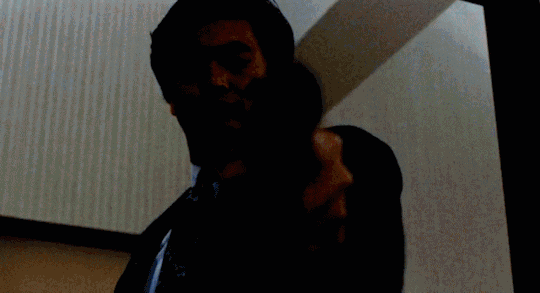
A filmmaker I'd like to discuss is Quentin Tarantino. He directs action films filled with drama. John Woo's films are mainly action but also involved some drama as well. He has had major influence from John Woo and his films and directing style of stylized violence, and he has said it himself but also it is evident through the way he directs his own movies too. Quentin Tarantino during an interview had said "John Woo was a big major hero to me at the time, I was just so influenced by Hong Kong cinema" (https://www.youtube.com/watch?v=yAck19uYAv0). What Quentin took away from John Woo is just the beauty of directing action cinema. You can film it in so many ways, but the way John Woo does it keeps everything fresh and intense. He uses intense dialogue, similar to a Hong Kong action film, and unexpected but thrilling action.

Certain ways John Woo has directed has had an influence on today's action films too. In Hard Boiled there is an action scene through the hospital that lasts two minutes and 42 seconds with no cut, it is an extremely long take from John Woo. In this scene, "the usual Woo hallmarks are on display: a hero wielding twin automatic pistols, slow motion, as well as the use of a technique rarely seen in his movies – filming the majority of the set piece in one take. The use of an unbroken shot...allowed the unseen set designers to alter the location to fit the requirements of the sequence while also enhancing the audience’s enjoyment of the action" (AllTheRightMovies).
youtube
Later action movies utilized this, such as Prachya Pinkaew’s Protector. In this movie he "has a memorable set piece that’s a perfect example of how a one take action scene can showcase both a lead character’s martial arts prowess and the imposing location he must traverse in order to confront the bad guys" (AllTheRightMovies). Prachya took inspiration from John Woo and utilized a great technique for action films to make the scene more effective.
youtube
Quentin Tarintino filmed the Kill Bill movies, which was seen as "his own take on 70s Japanese, Chinese, and Hong Kong martial arts movies including legendary actors from the era like Sonny Chiba and Gordon Liu" (Harvey Gough).
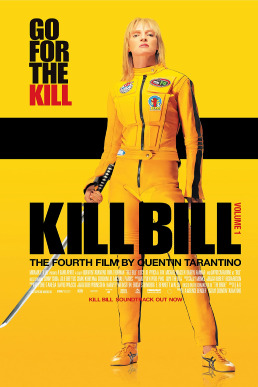
The Wachowski sisters directed The Matrix movies, which dove more into their "wuxia influence with increasingly extreme displays of martial arts" (Gough). Other notable films like Underworld, Blade 2 and Equilibrium "embraced the Hong Kong action sub genres gun fu (martial arts involving superhuman skill with guns) and heroic bloodshed (violent melodrama), which were popularized by directors John Woo and Ringo Lam in the late 80s and 90s" (Gough).

The director I mainly focused on today is John Woo, who has had a major influence on the genre of action cinema today. With his unique directing styles, it is clear why so many people use parts of his style in today's films, because it is so great and refreshing.
Sources:
youtube
0 notes
Text
Hong Kong Action Cinema (Blog 2)
For my second blog about Hong Kong action cinema, I decided to take a closer look into one of the greatest Hong Kong action films made. We all know John Woo can be considered one of the greatest filmmakers of the genre, so I dove into one of his most notorious films: Hard Boiled.

Released in 1992 and clocking in at two hours and eight minutes, this film is amazing. It gets going right from the jump with the action, at the beginning in the tea restaurant. It leaves the viewer with no shortness of action throughout the entirety of the film, and has a sweet conclusion as well.
Heres a semi-detailed summary for some background knowledge on how this film goes. The film follows a policeman, Tequila.

He is the main character we see throughout the film, and his role is simple; a Hong Kong police officer. He is chasing after two different gangs, the Triads who are led by Uncle Hoi, and also Johnny Wong's gang. One of these gangs killed his partner so he's out for revenge. We see another main character introduced in the film, Alan.
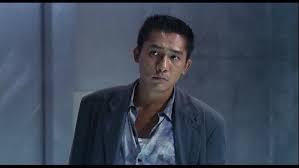
He is working for Uncle Hoi to kill, but nobody knows he is actually an undercover cop. Impressed by Alan's gun skill, Johnny Wong recruits him to work for him, and betray Uncle Hoi.
While all this is going on, Tequila finds out Alan is an undercover cop, and they eventually start working together. The triad's lair gets raided by Wong's gang, and Uncle Hoi and most of the gang die, thanks to Alan. Now Alan has Wong and his gang on his side, and when he confronts Tequila at the lair, this is when Tequila realizes he is actually a cop (because Alan lets him live).
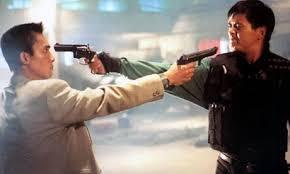
Then Tequila confirms his belief at Alan's boat, where they work together to fight off the rest of Hoi's gang. This is the part in the film where a duo is introduced, and the rest of the action involves Tequila and Alan working together as a team. We get taken to a hospital where another undercover cop who was on Wong's team, gets figured out and is a huge target. We remain at this hospital for the remainder of the movie, roughly about an hour. Tequila and Alan figure out Wong's lair is under the hospital, so they are fighting them the remainder of the movie. To prevent spoilers I will not say the ending, but what we see is a beautiful action-packed ending, where teamwork and trust become huge factors. Bombs are set in the hospital by Wong, and everyone is fighting for their life, while Tequila and Alan are fighting for revenge and justice.
John Woo does a great job at never letting the action get boring. We see pistols, shotguns, SMGs, LMGs, RPGs, and grenades all incorporated as weapons of use in the film to get viewers on the edge of their seats. John Woo uses slow-motion, and multiple angles during every fight which spices things up. We also see a great plot-line involved in this film, between a love story, brotherhoods formed, and justice being served. The plot is simple for this film: cops fighting bad guys, but it is so much more than that.
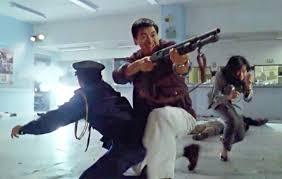
A scene that really stuck with me that I'd like to analyze, is the closing action scene. Wong has all the power in his hands, after blowing up the hospital and having a gun pointed to Alan's head. He uses this power to embarrass Tequila, but Alan pulls a fast move and grabs Wong's gun to shoot himself in the chest, allowing Tequila to finish Wong off. This is the teamwork I had touched upon earlier, because they both knew they had to do something, and they were both ready because they developed that brotherly connection throughout the film. It isn't one of the most action-packed scenes, but in my opinion it is the most important one. I could not find the scene on YouTube, but here's another great one from the hospital, Alan using deception to make this scene work.
youtube
Barbara Scharres, of The Criterion Collection, states "It is filled with images of departure and closure, of impending death, fear of the unknown, and regret for what is not to be. In terms of the bravura with which Woo stages the action, the film is unparalleled in its fiery invention and technical virtuosity, a fact which points out all the more that for the first time in one of his films the relationship between the central characters—the cop Tequila, and his compromised undercover counterpart Tony—is one of wariness and grudging respect rather than all-out trust " (Barbara Scharres). This describes the film in a perfect way, applauding Woo's directing style but also acknowledging the unique plot used between Tequila and Alan's relationship.
When talking about Tequila and Alan's purpose, Zsoro from Medium, states "the audience comes to understand these two men are fundamentally good; they are loyal to the side of justice, even if they have to shoot their way out and harrow their souls along the way to its delivery" (Zsoro). Thats their purpose, unsentimental combat for revenge and justice will no ill-intent. "Heroic Bloodshed" (Zsoro) was a great way to describe this film, because there was a lot of blood but it was all in the name of justice. A final touch upon this point, "Hard Boiled, like A Better Tomorrow (1987) and The Killer (1989) before it, comprises this arena of heroic bloodshed, with stylized action set pieces setting heavy duty cops against Romantic robbers. Each side of the conflict is armed with a mastery of “gun fu” and their own self-determined sensibility for what constitutes justice" (Zsoro).

This film paved the way for a lot of the more modern action films we see today, such as Fast and Furious where slow motion is used and lots of gunfire with many different interesting angles, and a hell of a storyline.
0 notes
Text
Hong Kong Action Films Blog 1
Hi everyone, my name is Jimmy Lee and for my global cinema class I chose to dive into the world of Hong Kong action cinema. I intend to analyze more of the genre of East Asia, as well as learn more about it myself as I go along! I love film, and my favorite genres are 80s horror/slasher movies, and also action movies from the 2000s.

(Fast and Furious)
This genre emerged in the 70s, but skyrocketed in the 80s so this will be a new realm of film for me to dive into. Action movies are some of the best movies out there for me because there is always something going on, so I am excited to analyze Hong Kong action films and the history behind it! My goal with this blog is to educate not only myself, but others too about the world of Hong Kong action cinema.
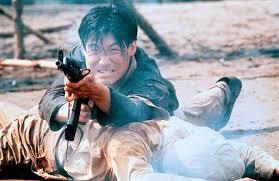
(Bullet in the Head, 1990)
To start off, Hong Kong action cinema was super important for Hong Kong's film industry as a whole, basically putting Hong Kong on the map in the cinema industry. It is one of the biggest, if not biggest factor in why Hong Kong cinema is known globally to this day. From the title "action film" it tells the basis of what the industry and films are generally about, but it's not just endless gun fights and conflict. It is known to also weave great Chinese storytelling into its action whilst using traditional Chinese film techniques. This makes the genre so diverse and versatile, incorporating unique filmmaking styles which is why this industry competed with Hollywood at one point.
This genre, also known as Hong Kong New Wave, is known to have emerged in the 1970s with a lot of people arguing its prime being had in the 1980s. Hong Kong's cinema industry had been lacking before then, so new up and coming directors decided to take a different approach to Hong Kong cinema to revise the genre and bring it back to life. With directors such as John Woo, Patrick Tam, and Tsui Hark, they took the films to a whole new level with action cinema. Some of John Woo's most popular action films are Hard Boiled from 1992 and A Better Tomorrow from 1986. Patrick Tam contributed with popular films such as Nomad and Final Victory, and Tsui Hark had directed Twin Dragons and Yes, Madam!
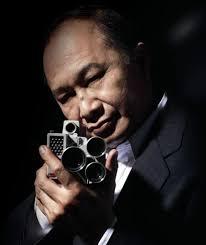
(Director John Woo)
A lot of people look up to these directors as the founding fathers of Hong Kong action cinema and credit them to making it so popular. if it was so popular, what was the reason? Well, they implemented innovative styles of directing and filming, to give viewers a breath of fresh air. of course these films weren't the first ever action films, but it was a spin off of something that was already great, which is why I'm talking about it today. A lot of movies, specifically action movies, of today can give thanks to these influential films and directors, as well as the actors too. Just to briefly touch up on some of the new film techniques being used that I've been talking about, here are some of the most innovative techniques used by Hong Kong action cinema directors:
Dramatic gunplay in fights, and dramatic fights in general to make them seem more interesting and unpredictable.

During these gun fights and action, slow motion was used to give it a dramatic effect, which makes it so innovative.

The story telling also was not straightforward, but in a good way. It had the viewer putting the pieces together like a puzzle (instead of having viewers watch and not analyze the plot) and this created a different approach to the narrative structure of the films which was new to most people.
Editors also worked hard after film sessions, trying different things while editing to keep things fresh, with the help of lots of special effects.
Hong Kong action films may seem straightforward from the name, until you press play and really take in the nature of the films. Innovative techniques, editing, and odd but creative storytelling helped bring a new approach to the film industry, which helped lift the Hong Kong industry to the mainstream and make it known around the world!
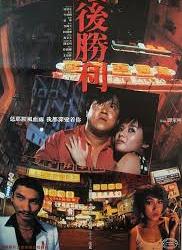

1 note
·
View note